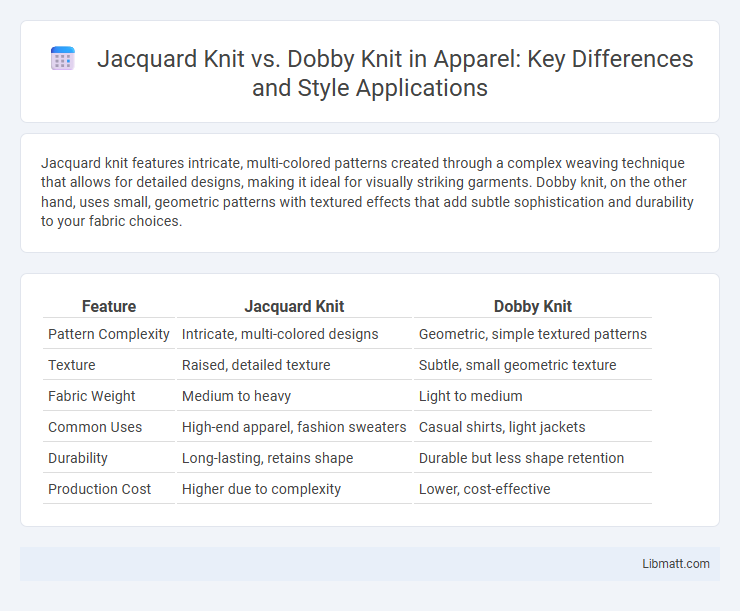Jacquard knit features intricate, multi-colored patterns created through a complex weaving technique that allows for detailed designs, making it ideal for visually striking garments. Dobby knit, on the other hand, uses small, geometric patterns with textured effects that add subtle sophistication and durability to your fabric choices.
Table of Comparison
| Feature | Jacquard Knit | Dobby Knit |
|---|---|---|
| Pattern Complexity | Intricate, multi-colored designs | Geometric, simple textured patterns |
| Texture | Raised, detailed texture | Subtle, small geometric texture |
| Fabric Weight | Medium to heavy | Light to medium |
| Common Uses | High-end apparel, fashion sweaters | Casual shirts, light jackets |
| Durability | Long-lasting, retains shape | Durable but less shape retention |
| Production Cost | Higher due to complexity | Lower, cost-effective |
Introduction to Jacquard Knit and Dobby Knit
Jacquard Knit features complex patterns created by controlling individual needles on the knitting machine, allowing for intricate, multicolored designs often used in fashion and home textiles. Dobby Knit is characterized by small geometric patterns and textures produced through a dobby loom's mechanism, providing a structured yet lightweight fabric ideal for shirts and blouses. Both techniques enhance fabric surface aesthetics but differ significantly in pattern complexity and production methods.
Understanding Jacquard Knit Fabric
Jacquard knit fabric features intricate, multi-colored patterns created through a complex weaving process that allows for detailed designs and textures. Unlike dobby knit, which produces small geometric patterns using a simpler mechanism, jacquard knit can incorporate elaborate motifs and larger designs due to its individual yarn control. This versatility makes jacquard knit ideal for decorative textiles where detailed imagery and dimensional effects are desired.
Exploring Dobby Knit Fabric
Dobby knit fabric features intricate geometric patterns woven into the material, created using a specialized dobby loom that controls individual warp threads for detailed texture. This fabric offers enhanced durability and breathability, making it ideal for shirts, casual wear, and upholstery applications where pattern and structure are essential. Compared to jacquard knit, dobby knit patterns are generally smaller and more repetitive, resulting in a subtle yet sophisticated texture.
Key Differences Between Jacquard and Dobby Knit
Jacquard knit features intricate, multicolored patterns created by controlling each stitch individually, whereas dobby knit produces small, geometric designs using simpler weaving techniques. The complexity of Jacquard allows for more detailed and vibrant motifs, while dobby knit typically offers textured, repetitive patterns with less color variation. Your choice between Jacquard and Dobby knit will depend on the desired design complexity and fabric texture.
Design Capabilities: Patterns and Textures
Jacquard knit offers complex, multi-colored patterns with intricate motifs created by controlling each stitch individually, enabling detailed and large-scale designs. Dobby knit produces small, geometric, and textured patterns through mechanical weaving techniques, focusing on repetitive textures rather than elaborate color variations. Both techniques enhance fabric aesthetics but differ significantly in pattern complexity and texture dimensionality.
Fabric Construction Techniques
Jacquard knit fabric features intricate, multicolored patterns created by independently controlling each stitch on a specialized knitting machine, allowing complex designs with varying textures and colors within a single piece. Dobby knit fabric is produced using a dobby loom mechanism, forming small geometric patterns or textures through a controlled combination of warp and weft threads, resulting in subtle, repetitive woven motifs. Understanding these fabric construction techniques helps you choose between the elaborate, detailed imagery of jacquard knits and the minimalist, textured appearance of dobby knits for your textile projects.
Durability and Wear Performance
Jacquard knit fabrics are known for their complex, multi-colored patterns created through a weaving process that integrates design directly into the fabric, resulting in high durability and excellent wear performance due to the strong interlocking of yarns. Dobby knit features smaller geometric patterns and a lighter texture, offering moderate durability but slightly less resistance to wear compared to Jacquard because of its simpler weave structure. If you require long-lasting fabric for frequent use, Jacquard knit is generally the better choice for enhanced strength and sustained appearance over time.
Aesthetic Appeal and Applications
Jacquard knit features intricate, multi-colored patterns created with complex weaving techniques, offering a high aesthetic appeal ideal for statement pieces and fashion-forward garments. Dobby knit, characterized by small geometric patterns or motifs woven into the fabric, provides subtle texture and elegance suitable for casual wear, uniforms, or home textiles. Understanding these differences helps you select the most appropriate knit for your design needs, balancing visual impact with functional application.
Cost and Production Efficiency
Jacquard knit fabrics typically incur higher production costs due to their complex patterns and longer machine setup times, requiring specialized jacquard knitting machines that increase manufacturing expenses. In contrast, dobby knit methods offer greater production efficiency and lower costs by utilizing simpler, repetitive geometric patterns and faster production cycles on standard dobby machines. Manufacturers often choose dobby knit over jacquard knit when cost reduction and faster turnaround are priorities without the need for intricate textile designs.
Choosing the Right Fabric for Your Needs
Jacquard knit features intricate patterns created by complex weaving techniques, making it ideal for bold designs and textured finishes, while dobby knit offers smaller, geometric patterns with a lighter texture suited for subtle elegance. Your choice depends on whether you prefer detailed, statement fabrics or understated, refined textures that enhance comfort and style. Understanding the distinct visual and tactile qualities of these fabrics helps ensure you select the ideal material for your specific fashion or interior design requirements.
Jacquard Knit vs Dobby Knit Infographic

 libmatt.com
libmatt.com